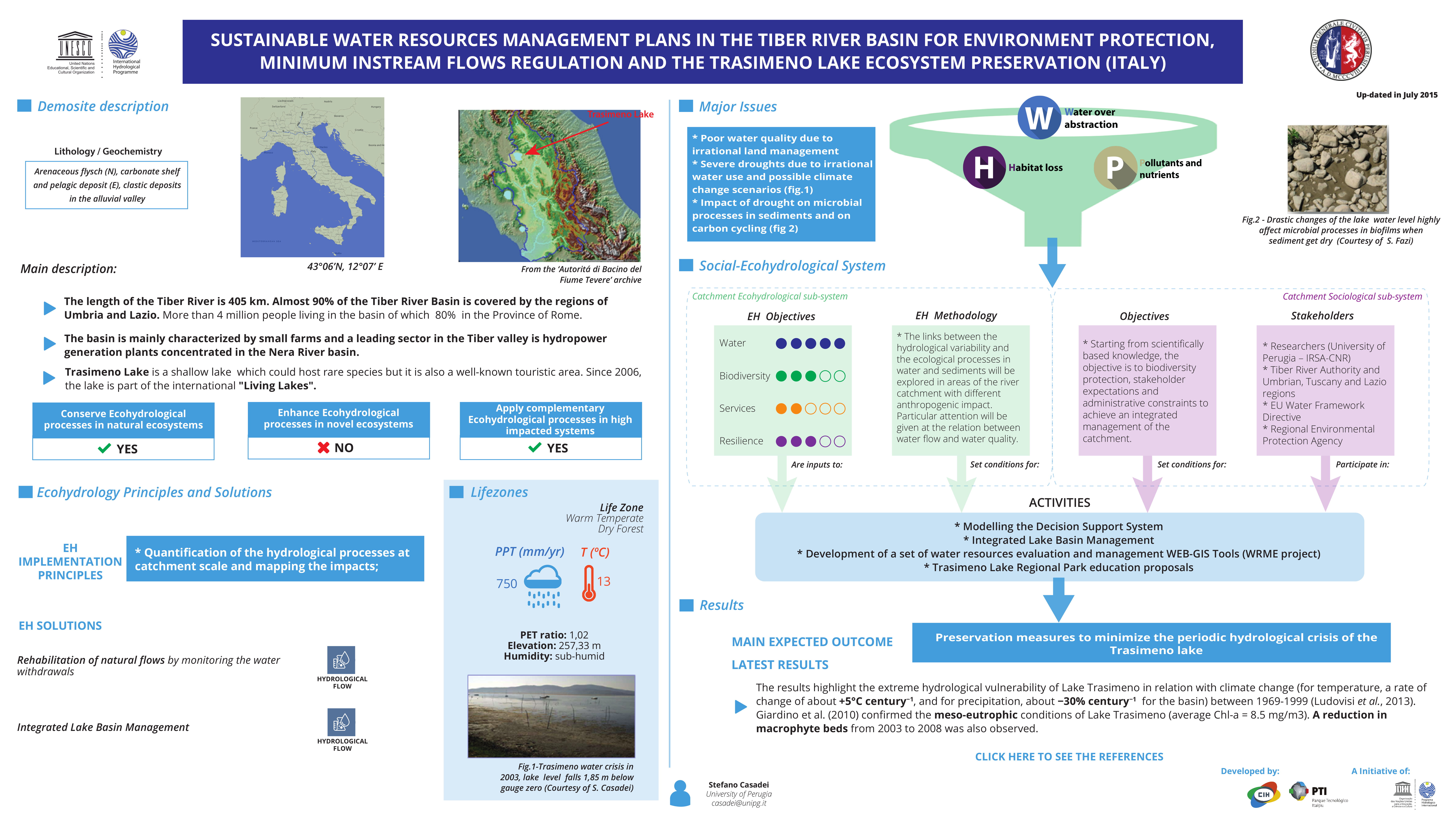SUSTAINABLE WATER RESOURCES MANAGEMENT PLANS IN THE TIBER RIVER BASIN FOR ENVIRONMENT PROTECTION, MINIMUM INSTREAM FLOWS REGULATION AND THE TRASIMENO LAKE ECOSYSTEM PRESERVATION (ITALY)

Description
Location


Sketch

Information about lithology/geochemistry:
Arenaceous flysch (N), carbonate shelf and pelagic deposit (E), clastic deposits in the alluvial valley
Main Description
- The length of the Tiber River is 405 km. Almost 90% of the Tiber River Basin is covered by the regions of Umbria and Lazio. More than 4 million people living in the basin of which 80% in the Province of Rome.
- The basin is mainly characterized by small farms and a leading sector in the Tiber valley is hydropower generation plants concentrated in the Nera River basin.
- Trasimeno Lake is a shallow lake which could host rare species but it is also a well-known touristic area. Since 2006, the lake is part of the international "Living Lakes".
Enhance ecohydrological processes in novel ecosystem
NO
Apply complementary Ecohydrological processes in high impacted system
YES
This table presents the different categories of ecosystem services that ecosystem can provide, divided in:
Provisioning Services are ecosystem services that describe the material or energy outputs from ecosystems. They include food, water and other resources.
Regulating Services are the services that ecosystems provide by acting as regulators eg. regulating the quality of air and soil or by providing flood and disease control.

Waste-water treatment: Ecosystems such as wetlands filter both human and animal waste and act as a natural buffer to the surrounding environment. Through the biological activity of microorganisms in the soil, most waste is broken down. Thereby pathogens (disease causing microbes) are eliminated, and the level of nutrients and pollution is reduced.
Ecosystem services "that are necessary for the production of all other ecosystem services". These include services such as nutrient recycling, primary production and soil formation.

Habitats for species: Habitats provide everything that an individual plant or animal needs to survive: food; water; and shelter. Each ecosystem provides different habitats that can be essential for a species’ lifecycle. Migratory species including birds, fish, mammals and insects all depend upon different ecosystems during their movements.
Cultural Services corresponds nonmaterial benefits people obtain from ecosystems through spiritual enrichment, cognitive development, reflection, recreation, and aesthetic experiences.

Recreation and mental and physical health: Walking and playing sports in green space is not only a good form of physical exercise but also lets people relax. The role that green space plays in maintaining mental and physical health is increasingly being recognized, despite difficulties of measurement.
Lifezones

![]()
PPT(mm/yr): 750.0
![]()
T(ºc): 13.0
| Elevation of demosite: | 257.0 meters above sea level |
| Humidity: | Sub-Humid |
| PETr (by year): | 1.02 |
EH Principles
Quantification of the hydrological processes at catchment scale and mapping the impacts
ECOHYDROLOGY ENGINEERING SOLUTIONS
Integrated Lake Basin Management
 Hydrological Flow
Hydrological Flow
Rehabilitation of natural flows by monitoring the water withdrawals
 Hydrological Flow
Hydrological Flow
Major Issues
- Poor water quality due to irrational land management.
- Severe droughts due to irrational water use and possible climate change scenarios.
- Impact of drought on microbial processes in sediments and on carbon cycling.





Expected Outcomes
Preservation measures to minimize the periodic hydrological crisis of the Trasimeno lake
Latest Results
- The results highlight the extreme hydrological vulnerability of Lake Trasimeno in relation with climate change (for temperature, a rate of change of about +5°C century¹, and for precipitation, about −30% century¹ for the basin) between 1969-1999 (Ludovisi et al., 2013). Giardino et al. (2010) confirmed the meso-eutrophic conditions of Lake Trasimeno (average Chl-a = 8.5 mg/m³). A reduction in macrophyte beds from 2003 to 2008 was also observed.
Contacts
Stefano Casadei
- casadei@unipg.it
- www.unipg.it
- University of Perugia
- www.unipg.it

Social ecohydrological system
EH Objectives
EH Methodology
Catchment Ecohydrological sub-system
Objectives
Stakeholders
Catchment Sociological sub-system
Activities